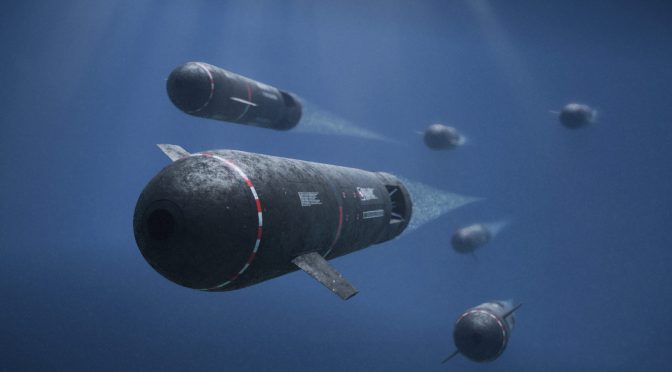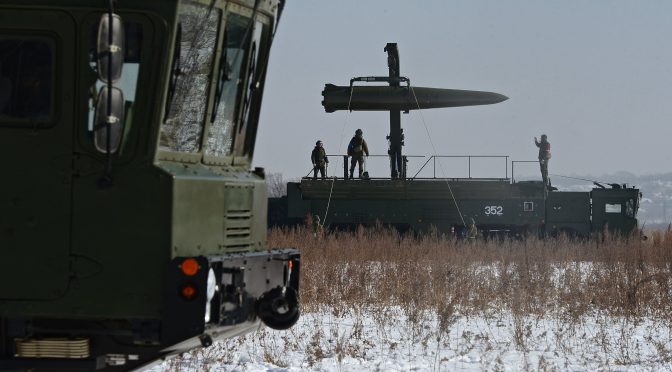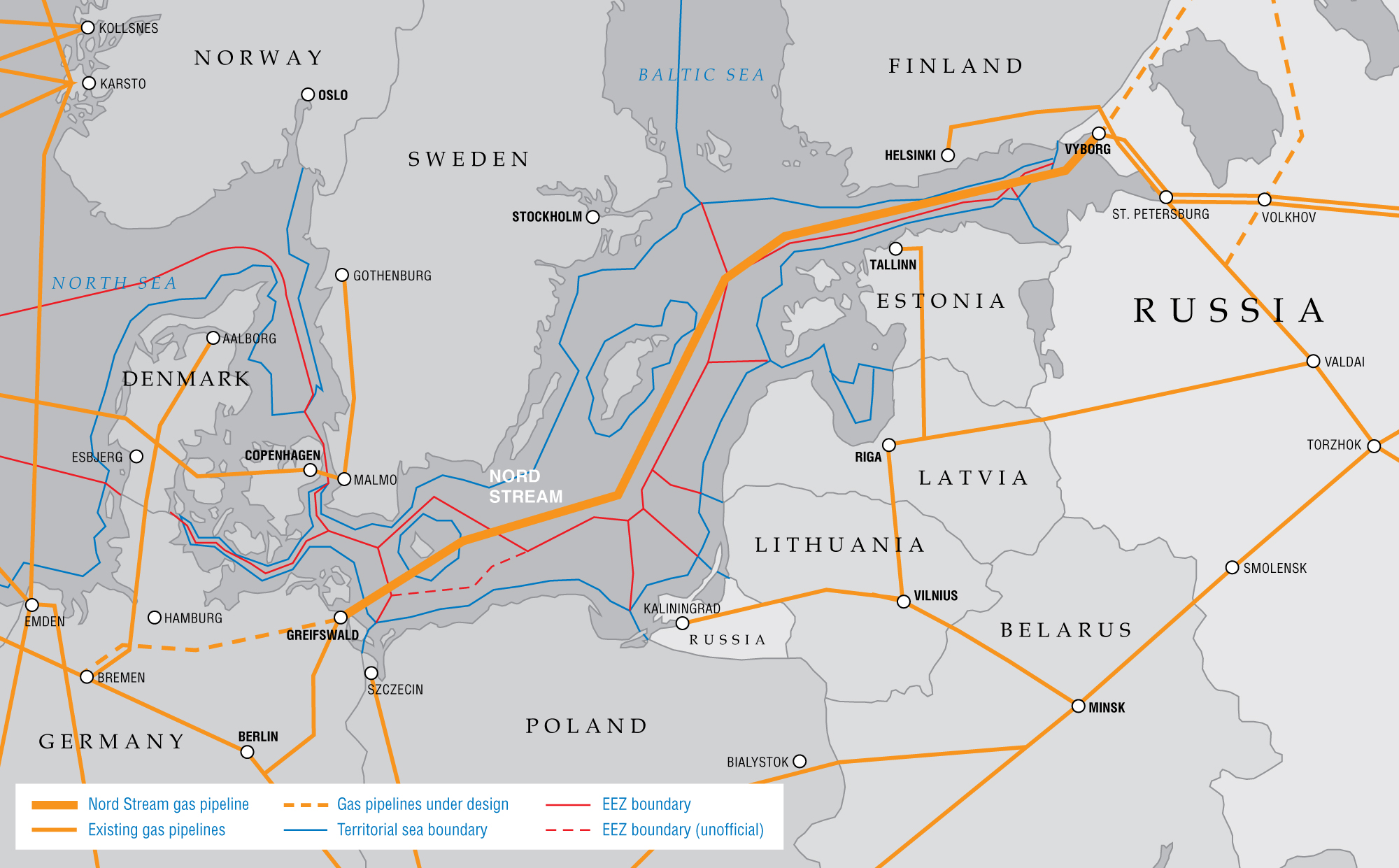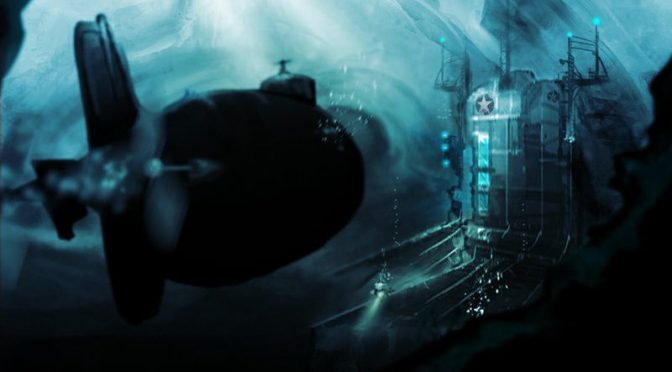By Evan D’Alessandro
The containers arrived at Norfolk early in the morning, with the snow a powdered sugar-like dusting on the trucks as they moved through the port. The darkness failed to hide their arrival from the Russians watching them through the hijacked security cameras. Another shipment in the cold weather of nondescript containers, their true propose not yet revealed. The containers had traveled for 36 hours to arrive on time and be loaded onto the requisitioned container ship MV Lt. Lyle J. Bouck. The watching Russians marked the containers as convoy supplies without a second thought, oblivious to what they had just missed.
Days before the containers were moved an AI had considered each ship’s cargo carefully. It speed, tonnage, fuel, acoustic signature, and survivability from a number of threats were all variables in the calculation. Ultimately, the AI decided that this convoy was not worth protecting. The cargo was all non-personnel, and the ships were old and only the commander’s ship was manned. The Navy had been stretched thin even with the Royal Canadian Navy and the Coast Guard ships that had been pressed into convoy duty. No ships would be assigned to protect them. They would be listed as unprotected, having to use the winter storms to shield themselves from satellites, as they attempted to dash across the Atlantic, praying for the best.
Vasily Sokolov read the report gleaned from a backdoor purchased off the Dark Web, checked the box for ‘no escort’ and moved on. He scrolled through the supply manifest slowly and then pulled up the satellite imagery for the ships, a satellite composite only four hours old. The only visible armaments on the ships was the M109 Paladin, undoubtedly with its hypervelocity projectiles for air and missile defense. It sat atop a stack of red and blue containers, moored to them by large metallic brackets. A bulky cable snaked its way back to the superstructure of the ship, terminating in its dark underbelly. Vasily checked the ‘3D’ box and turned the ship, revealing a short ugly dome perched atop the superstructure, the predictive software pulling from known ship plans and previous satellite imagery. Quickly checking the projected dimensions on the dome against shipment records, Vasily confirmed that it contained the fire control radar that had been bolted on by techs the day before. With three of the ships in the convoy carrying a Paladin, it was hoped there would be some protection from hypersonic missiles. Vasily chuckled, as if missiles would be wasted on these low-value ships. A quick look at the aft decks of the ships confirmed that each was carrying two ‘Grasshoppers,’ the ASW drone that the Americans used. As he moused his way through the other ships, he could see Paladins emplaced onboard the other convoy ships, and prefabricated hangers being assembled on the back decks for the Grasshoppers. The tiny dots of technicians on his computer screen would be working through the night to get them finished in time to depart on their dangerous voyage.
The convoy sailed at 0800, picking up a low-pressure front that the predictive weather AI’s expected to turn to rain in the next 16 hours. The winter storms of the Atlantic were notorious, but the front seemed destined only for continual, dismal rain. The Grasshoppers went to work immediately, making sure that they weren’t picking up a tail when they exited the anti-drone net across the mouth of the harbor. The cycle of one hour on, two hours charging would continue as long as the weather permitted.
At 2100, in the darkness of the cloudy night, the containers were opened. Large cylinders were wheeled out and quickly put underneath the superstructure and covered in canvas. In the morning, they would be unseen by any satellite that managed to catch the convoy, and the Russians would be none the wiser. The convoy’s secret weapon, two Mk. 2 Autonomous Underwater Combat Vehicles (AUCVs) were prepared for battle. As their last restraint was being tightened the rain began, cloaking the convoy in its misty hold; the convoy would hide under this front for the rest of its journey.
Vasily Sokolov looked at the computer screen and leaned back. He stifled a yawn, and longed to go back to bed, but, no, there was a war going on, and his job needed to be done. His eyes ran down to the last box simply titled ‘Recommendations.’ Once again he paused, the convoy was equipped to deal with hypersonics, but not torpedo carriers, so that’s what he would recommend. One should be enough for an unarmed convoy, no, two for safety. Better safe than sorry his father had always said. Give them torpedo interceptors? No, the convoy wouldn’t be able to fight back, they only had 12 Grasshoppers. Better to load as many torpedoes as possible. His mind made up, Vasily Sokolov cracked his fingers and began to type.
The rain had begun to lessen in the middle of the Atlantic as the Captain arrived on the bridge from her all too short sleep. The USNR had called her up, and assigned her to what she considered to be little more than a oversized bathtub with propellers. The Captain’s voice echoed out across the bridge as she put on her VR display. “What does the report say?” The Tech looked out at the whitecaped waves as the threat report started to print out.
“Report for 41°37’41.5″N 31°33’22.5″W. Two Type 34 Autonomous Torpedo Carriers detected, no other threats at this time.”
“Two Mother Hens” the Tech called out, “both are probably carrying a full load of eggs, no interceptors, the Autonomous Acoustic Monitoring AI predicts them to be here, but no one’s sure.” The Captain grumbled, she had never been comfortable with the idea of the football-sized drones floating through the water replicating SOSUS, but it was undoubtedly effective. “They went silent 4 or 5 hours ago, switched over to electric,” the Tech continued. “Any idea on what type of eggs?” the Captain asked with her light southern drawl. “Nope, the report has nothing on the torps,” the Tech replied wearily once again staring back out at the waves. The captain sighed as she stripped off the VR display, and went off to make up for her lack of coffee. For a brief moment her eyes gazed across the overcast rain and the Grasshoppers doing their job. There was nothing else she could do.
Ten miles out the Mother Hens were studying the acoustic signatures of the convoy. The onboard AI’s knew everything that Russian Naval Intelligence had gleaned about the convoy and were locked in deliberations. After a few minutes, they decided on a simultaneous pincer movement from the front and back as their plan of attack, and both slowly set off to get into attack position.
Grasshopper 4 was completing a set of passive dips on the north side of the convoy as droplets of rain pinged off its aluminum body. It had just popped up and moved 300 feet further north, covering the left flank of the convoy, and lowered its sonar when something unexpected happened. Imperceptible to the human ear, but detectable to the computer was a slight rumble. The computer reached a decision in seconds, deciding to stay put in the cold, grey rain, and requested Grasshopper 7 to immediately move into the area. Onboard the Bouck, a track popped up on the freshly-caffeinated Captain’s VR display, simply reading ‘possible threat.’ Beneath the waves of the Atlantic, the Mother Hen continued on its way oblivious to the threat above. Grasshopper 4 asked for permission to go to active sonar but the Captain denied it as Grasshopper 7 sped its way towards Grasshopper 4, and the Bouck’s own Grasshopper 9 lifted off. The active could wait. As Grasshopper 4 waited it compared the rumble to previously recorded signatures in the Grasshoppers’ database, the VR display showing a rapidly increasing chance that the contact was a Mother Hen. Calmly, the Captain watched the hostile track as the probability reached 60 percent, and then gave the order to fire.
Across the waves, Grasshopper 4 dropped the lower part of its body. The dull-grey, square casing discarded from the torpedo as it fell into the black water below, and the torpedo immediately went active. The Mother Hen detected the crash of debris ahead, and within milliseconds of hearing the first ‘ping,’ let off its own countermeasures. On the Bouck’s bridge the Captain looked on at the command map. Three of the four-noisemaker patterns were known, having been stolen from Russian firms under cyber espionage, and the torpedo immediately ignored them. The fourth noisemaker was unknown, and the Captain watched as the torpedo waivered for a heart-stopping second, then turned to chase the first Mother Hen.
The first Mother Hen had made it far too close to the convoy, nearly guaranteeing a hit with its torpedoes. The onboard AI considered trying to run but discarded the idea instantly. With an air of sadness, the first Mother Hen turned in towards the convoy and the oncoming torpedo, and unceremoniously fired all of its ‘eggs.’ A wave of torpedoes lanced out in a spread: the Hen’s final gamble. As the torpedoes left, the two canisters on the Mother Hen’s back were blown upwards in a silver stream of bubbles towards the surface. One immediately broadcast the position of the convoy and the fate of the doomed Mother Hen. The second one popped out, and with an eruption of fire flew after Grasshopper 4. With little formality the missile closed, as Grasshopper 4 tried to hug the dark ocean for safety, before being turned into a bright ball of flame. The sorrow that was felt upon the loss of Grasshopper 4 was immediately overshadowed by the churning sea that signaled the death of the Mother Hen. Grasshopper 7 dipped into the cold waters and went active, ensuring that the Mother Hen was not playing dead. No return on the sonar. A confirmed kill.
Onboard the Bouck, the VR display changed to ‘threat destroyed.’ On the bridge, the Captain had already ordered a hard turn to starboard, turning parallel to the torpedoes and minimizing the convoy’s cross section. With the threat of incoming torpedoes and the possibility of a second Hen, the Captain unveiled her trump card. With an unceremonious crash into the Atlantic, the two carefully hidden Mk. 2 AUCV’s dropped into the waves, their long grey forms diving into the depths. All available Grasshoppers simultaneously rose from their charging ports in a frenzy of activity, as they moved across the convoy seeking out their enemies.
One of the Mk. 2’s now sat underneath the hull of the Bouck, trying to hide the fact that two were now in the water. The other Mk.2 assessed the incoming torpedo spread. The Mk.2’s AI pulled information from Grasshopper 7 and its own sensors, overlaying the convoy’s turn, and projecting forward. Three threats, the Mk.2 AI decided, and it dived and launched. Six ‘Silverfish’ torpedo interceptors raced out from the Mk. 2, closing in on the inbound torpedoes. The Captain looked on from the bridge. By the way the Mother Hen’s torpedoes were dodging, it was obvious they were outdated; clearly the Russians had underestimated the convoy’s defenses.
The Silverfish jabbered the whole way there, determining the Mother Hen’s torpedoes’ type and patterns. The first torpedo went left when it should have gone right, meeting its end in a mess of debris. The second torpedo dodged the first Silverfish, slipping through by diving at just the proper time, only to be met by the second Silverfish. The third torpedo dodged left, then right, the first Silverfish missing by mere inches, shortly followed by the second Silverfish mistaking a feint for a move and shooting underneath the torpedo.
The Mk. 2 looked on impassively, quickly calculating the chance of hitting the third torpedo, and launched a further three Silverfish. The torpedo was within 1000 feet and closing as the Silverfish streaked towards it, separated by mere seconds. The torpedo danced left, right, up, and down in an attempt to throw off the Silverfish gaining on it. But in the end it was not successful, the second Silverfish tearing its engines to pieces leaving it dead in the water. The Captain looked up coolly from the command map, only to hear klaxons blare.
The second Mother Hen had made it much closer to the convoy, slipping in through the convoy’s baffles while they were distracted, and finding itself a wolf among a flock of sheep. Sitting under the hull of one of its prey, it reached its decision and cut its engines, drifting slowly back, unseen in the darkness of the Atlantic.
The Captain sat up in shock as the VR display squealed an alarm, ‘FISH IN THE WATER! FISH IN THE WATER!’ and twisted around to see the tracks of four torpedoes from the second Mother Hen heading towards the Bouck and her sister ship the Sgt. William L. Slape. Behind her the Mk. 2 that had dealt with the initial torpedo barrage spit out the last of its 12 Silverfish at the new incoming wave, hoping that the interceptors would overtake the torpedoes before they hit. A Grasshopper also dropped down behind the convoy and went active, trying to acquire the threat. Within a second, another barrage of torpedoes from the second Mother Hen headed towards two other ships in the convoy, traveling underneath the water, preparing to pop up and hit the ship’s hulls perpendicularly.
The Captain waved her hand and the VR display stopped its alarms and calmly showed the tracks towards her convoy. Below her the fresh Mk. 2 was considering its options. It could try to destroy the torpedoes targeting the Bouck and the Slape, or it could go after the torpedoes targeting the ships farther forward. Grasshopper 5 noticed a lack of sound as one of the torpedoes targeting the Bouck stopped accelerating; it was now unguided and slowing as its propeller stopped, the watertight seals failing and the engine being swamped. The tracks of the Silverfish from the first Mk. 2 glowed green on the VR display, but it was more than clear that they would not stop the torpedoes in time.
The fresh Mk. 2 made its decision, and started to flip 180 degrees. Halfway through its turn it launched all 12 of its onboard Silverfish towardsthe torpedoes planning to pop-up, and brought its motors onto full. The Captain watched as her Mk. 2 launched its Silverfish, and her VR display show a 94 percent kill chance on the torpedoes targeting the ships farther down the line. The fresh Mk. 2 dropped both its torpedoes on the now acquired Mother Hen and pushed its engines to full, accelerating towards the torpedo.
The VR display shuddered as the rear end of the Bouck was lifted six inches from the water and its rear decks were covered in a spray as the Mk.2 met the oncoming torpedo. The torpedo tried to fight until the end, but the Mk. 2 imposed its bulk between the torpedo and the Bouck. An explosion was seen in the distance, the death of the second Mother Hen that had attacked. There was a second of calm then the Slape lifted several feet in the air as she too was hit. Two great spouts of water shot up from the side of the Slape as the torpedoes impacted just below the waterline. The VR display made an all-clear noise as the Silverfish intercepted and destroyed the remaining torpedoes, overtaking them and shattering them into a thousand pieces. Damage reports flooded in from the dying Slape. Like stricken rats, the Slape’s Grasshoppers, recharging from their last shift, fled the ship as it filled with water quickly shuttling to open charging ports on other convoy ships. The VR display marked the Slape as a loss, with a bright red outline, as the Grasshoppers buzzed, diligently searching for more enemies.
Behind the convoy a beacon popped up transmitting the location and death of the second Mother Hen. The Captain watched its progress as the noise of the fight slowly faded from her ears. Slowly the Mother Hen’s beacon was swallowed into the Atlantic, along with the shattered wreck of the Slape. The rain slowly picked back up in intensity as it covered the convoy with its grey cloak.
Vasily looked once more at his computer screen as it displayed the fate of the Mother Hens. “Spasibo”, he said to himself as a wry smile grew on his face, “Thank you for showing me your countermeasures.” He perched a cigarette between his smiling lips, reached out, and began to type, “To all AI Anti-Shipping Deployments….”
Evan D’Alessandro is a student at Luther College studying astrobiology, data science, and international relations. He enjoys military history and policy debate, and aspires to become a naval intelligence officer in the future. He can be contacted at evan.dalessandro@gmail.com.
Featured Image: Torpedo Exexutor, concept art by Markus Biegholdt, 3D art by Miroslaw Cichon.






